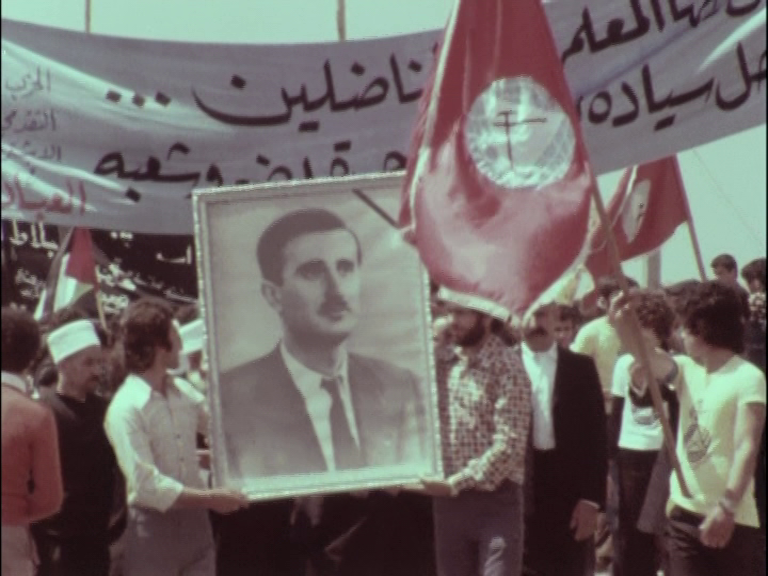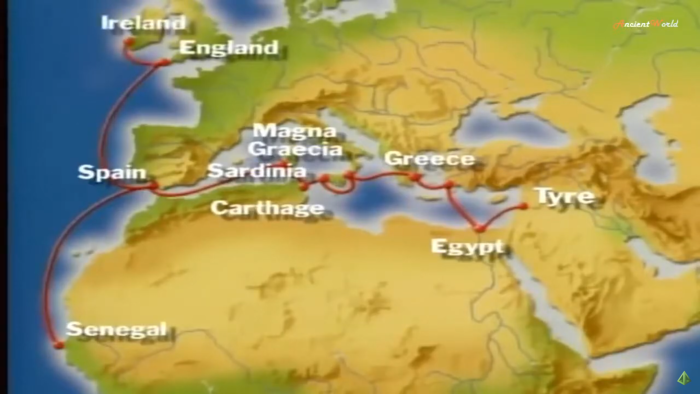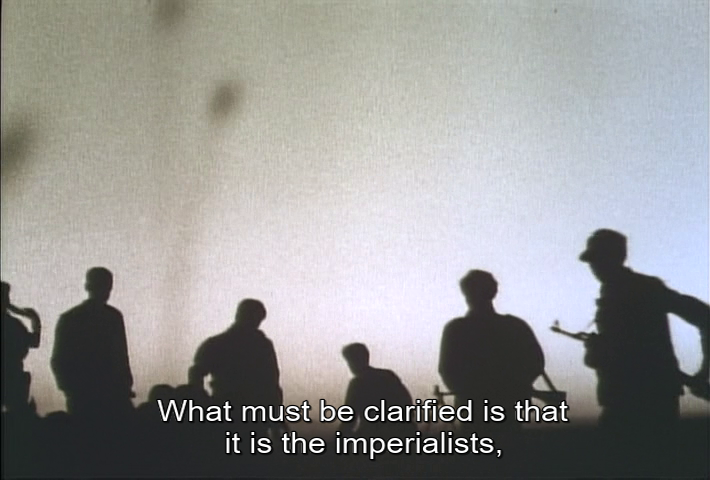CoMo No. 28: Lebanon (October, 2024)
Posted: Fri Oct 04, 2024 6:53 pm

a place to talk about movies and whatnot
http://scfzforum.org/phpBB3/

Mr. Salloum found a cache of deteriorating commercial film reels, trailers and commercials in an abandoned theater in Beirut in the 1980's. Many years later, inspired by the material as a historical marker of popular media culture during the era of the civil war and a document of western orientalism, Ms. Ahwesh edited some of the fragments together.
Beirut Outtakes is a small tribute to endurance, the history of decay and an examination of the export of American product.
Husayn ibn Ali (626-680) → https://en.wikipedia.org/wiki/Husayn_ibn_AliEvery year, thousands of Shia Muslims meet in the village of Nabatiyyeh in Lebanon to commemorate the martyrdom of Imam Hussein, assassinated in 680 A.D. It is by far the most important religious event in the Shia cult, and leads to the formation of immense mass movements all around the world. Mystic Mass describes extensively this 24h ceremony, and deconstructs its indivisible, ever united, mystic mass, since its formation early in the morning of Ashoura, up to its dissolution in the afternoon of the same day.




There was no religious aspect to Shi'ism prior to 680. The death of the third imam and his followers marked the 'big bang' that created the rapidly expanding cosmos of Shi'ism and brought it into motion.
Achoura: A celebration for Sunnis, a mourning for Shias
Achoura, celebrated on July 16 this year, marks the tenth day of Muharram in the Muslim calendar. For Sunnis, it is a joyful day celebrating the Exodus, while Shias mourn the martyrdom of Imam Hussein, the grandson of the Prophet Muhammad.


Interview with Karim B. Haroun, Director of ‘Mystic Mass’
→ https://www.popoptiq.com/interview-with ... stic-mass/
The first character of the cinema was the mass: In La sortie des usines Lumière, credited as the first ever film, a crowd of factory workers leave a factory. While on repeated viewings you could begin to pick out the quirks and personalities of certain subjects, the real character was the group, the mass, the crowd. Early cinema, in particular in the work of the Lumière’s was emblematic of this style, the cities, the environment and the crowd itself were almost always the subject: the individual would come later. As cinema grew as an industry, it eventually morphed into a cinema of the individual. This seemed natural, as the capitalist nature of industry was one that favored individual accomplishment above all else. This remains core to our central understanding of narrative filmmaking to this day, and with few exceptions (perhaps most notably the Russian cinema of the 1920s) remains the status quo.
With Karim B. Haroun’s new documentary, Mystic Mass, the religious mass is the subject.
...
Berlin and Beirut were occupied, destructed, divided, reconstructed and today people still say "East and West" in both cities.
Through the whole film Berlin and Beirut become one city. One space.
BerlinBeirut: A conversation with Myrna Maakaron
→ https://www.bidoun.org/articles/berlinbeirutBidoun: Why have you chosen to compare Berlin with Beirut?
Myrna Maakaron: Because I visited Berlin in February 2003, and discovered that it has the same vibrations and spirit as Beirut. Berlin touched my heart, especially since I was missing my city very much at this period (still now). I often look for places and faces similar to my Beirut. I found some in Berlin. Berlin was bringing Beirut to me. This is how the idea of the film was born.
...
During my script developing period I watched some Agnès Varda films and read “Threads of Time” by Peter Brook. Somehow these two artists gave me power to work and a certain inspiration.








loved this!


i masochistically “enjoyed” watching this film!Progressive Socialist Party → https://en.wikipedia.org/wiki/Progressi ... list_Party
Founded by Kamal Jumblatt in 1949, the party was led by his son Walid Jumblatt between 1977 and 25 May 2023.
On 25 June 2023 the son of Walid, Taymur Jumblatt, was officially consecrated as leader of the PSP.



yeah, war is peace!In September 1972, Kamal Jumblatt received the International Lenin Peace Prize.













This film is inspired by two events that shaped the filmmaker: his birth in Senegal, host country to his parents, and the internal tensions in Lebanon, signs of the civil war to come. A love of life opposes a destructive movement: a man's origins, as well as those of a nation, are compared and questioned in a context of exile, belonging and politics.
→ https://en.wikipedia.org/wiki/Lebanese_ ... in_SenegalIn 1958, in Senegal, the land of emigration, Zahia Salhab gave birth to her first child Ghassan.
During the same period, Lebanon, their homeland, is driven into a significant local conflict, a preamble to the next civil war.









Grandmother loses her five senses one after the other until she transforms into a wooden chair.
Throughout her transformation, she realizes that her housekeeper is not the wild animal she thought she was, but the real, caring, and strong family member grandmother was looking for.
https://www.zippyframes.com/shorts/how- ... as-fattouh
"One week after my grandmother's funeral, the family returned to grandma's house for the first time in a while to collect her belongings", Nicolas Fattaouh tells Zippy Frames. "Coincidentally, grandma's housekeeper, Asteer, moved to my house since my uncles had found someone to rent the house the next day". The housekeeper brought the grandma's chair with her, a piece of sentimental value that meant nothing to other family members. "I felt my grandmother's presence as if she had transformed into a piece of furniture to remain with her loved ones".
So, the project took off (one year in development) with an intimate goal to resurrect personal memories. Yet, research was also an indispensable element. "I volunteered for a few days at a retirement home located in the north of Lebanon and encountered abandoned seniors who were living in deplorable conditions. Their bodies were incredibly frail, and they relied heavily on the pieces of furniture they used, as if they had lost their own sense of presence". Fattouh sensed a merging of old people with the furniture -when he inquired the facility about this, they told him it is a result of loneliness. One after the other, the things they appreciated in life went numb. "The food they once enjoyed became tasteless, the perfumes lost their scent, the objects, landscapes, and things they once delighted in seeing became meaningless. The music and sounds around them became ambient and neutral, and even the textures they once found pleasurable lost their sensory impact".
Using a mix of animation, live-action footage, and photography, the Lebanese short film Waves ‘98 incomparably captures the deceptions and disappointments of the era in all its complexity and nuance, never offering us the simple solutions that we’ve become weary of as Lebanon spirals out of control. Set during the waste crisis of 1998 — an event chosen by its writer/director Ely Dagher as it was one of the few that affected everyone in Lebanon from all sects and both sides of the political spectrum — the film follows Omar, a Lebanese teenager wasting away in the segregated suburbs of Beirut, where his disillusionment with post-civil war life lures him into the city’s depths. There, Omar slowly loses touch with reality as he struggles to maintain his sense of belonging to the hollow world around him.
→ https://en.wikipedia.org/wiki/History_of_Phoenicia
Phoenicia was an ancient Semitic-speaking thalassocratic civilization that originated in the Levant region of the eastern Mediterranean, primarily modern Lebanon. At its height between 1100 and 200 BC
→ https://en.wikipedia.org/wiki/Tyre,_Lebanon
a city in Lebanon, one of the oldest continuously inhabited cities in the world, ... It was one of the earliest Phoenician metropolises and the legendary birthplace of Europa, her brothers Cadmus and Phoenix, as well as Carthage's founder Dido (Elissa).
→ https://en.wikipedia.org/wiki/Baalbek→ https://en.wikipedia.org/wiki/Carthage
The city developed from a Phoenician colony

all this ↑↑ reminds me of something ↓↓ i have seen yesterday (at the exhibition)...For an estimated population of 4 million, Lebanon boasts some 200,000 foreign domestic workers,
contracted under a system of full custodianship that deprives them of basic rights.
Implemented since the start of the civil war (1975), this system is borrowed from similar ones in the Gulf countries. It is predicated on a transaction whereby the worker is not providing a service but is rather commodified as a product,
with specialized agencies organizing their import under conditions not unlike modern-day outposts of slavery.
Director Maher Abi Samra places his camera inside the offices of the El Raed agency with the full complicity of its owner Zein. Diligently, unobtrusively, he observes and probes.
Artist: Mladen Stilinović
Title: Rad je bolest (Karl Marx) AKA Work Is Disease (Karl Marx)
Date: 1981
Malevich wrote a text entitled “Laziness — The Real Truth of Mankind” (1921).
In it he criticized capitalism because it enabled only a small number of capitalists to be lazy, but also socialism because the entire movement was based on work instead of laziness.


Shot in a pseudo-documentary style, Letter From a Time of Exile presents the stories of four Lebanese men whose lives have taken unexpected turns due to the Civil War: Abdallah, a former militia member; Karim, an unemployed journalist living in Paris; Rizkallah, a car salesman in Brussels; and Nessim, a surgeon who has settled in Strasbourg. Narrated with subtle humor, Letter From a Time of Exile is both a portrait of people in exile, and the cities in which they currently reside.
This thesis looks at the origins and early development of the film industry in Lebanon through the lenses of the political economy of media. Its aim is to understand how the country’s economic model has shaped the national film industry and its output. The choice of methodology has been dictated by a recurring, critical remonstrance in the scholarship on Lebanese cinema. The lack of state funding and of “recognizably Lebanese” films have often been adduced as the Achilles heel of Lebanese cinema by scholars and critics alike. In my thesis I frame them on the contrary as constitutive and defining elements of the Lebanese film industry and, therefore, as pertaining to the national character of the country. I start by placing the origins of cinema in Lebanon in the colonial context, to analyze how this has impacted its historical shape and industrial orientation. After having established the ascendancy of distribution and exhibition over production that characterized the early days of cinema Lebanon and pointed to the economic reasons behind this tendency, I proceed to observe how production picked up in the in the early 60s and look at the kind of film that were produced and shot in the “Switzerland of the Middle East.” Though these films were often foreign (co-productions) and featured stereotypical tropes about Lebanon and its capital, I argue that what they represent both textually and contextually should not be dismissed. Their commercial vocation and expendability are not a negation of national cinema, as scholars have argued, but a faithful reflection of the country’s cultural priorities. Conversely, when looking at those film that have been unanimously considered “distinctively Lebanese,” I critically dissect them to show that their national attributes are actually partial and end up reflecting the country’s fragmentation rather than its imaginary essence. I finally argue that the impossibility for cinema to faithfully reflect the nation that produces it is characteristic of both the medium itself and the artificial construct of nationalism.



After “Letter From a Time of Exile”, the director is back in Lebanon where he discovers that his dreams about his country are an illusion and that exile in your homeland is by far the worst exile.
His film constitutes a new letter at the start of the 21st century in reply to the letters of the 1980s.
The reconstruction process appears to affect stones more than people.
Review by kanafani ↓↓
Director Christian Ghazi joined the Palestinian liberation movement in 1968 and took part in covert military operations inside the occupied territories throughout the seventies, often capturing the fighting with a hand-held camera. He filmed dozens of movies in Lebanon, mostly documentaries chronicling the struggles of resistance fighters, refugees camp dwellers, tobacco farmers and factory workers. His entire body of work was destroyed during the Lebanese civil war, when in 1983 militia fighters broke into his home on a cold day and burned all his film negatives to make a bonfire. He was devastated, and quit making movies in disgust. He remained a mainstay of the coffeshops of Hamra street in Beirut for years, spending his days playing checkers and having heated cultural and political discussions with his old road companions, as well as members of the younger generation. He died in 2013.
This, his only surviving movie, is quite a rarity: A politically engaged avant-garde work of fractured fiction, centered on Palestinian resistance fighters, their families, and their Lebanese road companions in the aftermath of black September (the expulsion of PLO leadership and its fighters from Jordan, and their resettlement in Lebanon). It’s a kaleidoscopic, dizzying work, in the tradition of Vertov and Eisenstein, with a very inventive soundtrack, sometimes consisting of cacophonous radio static, often creating meaning through the juxtaposition of conflicting sound and image: Images of an oblivious Lebanese bourgeoisie living it up in a nightclub superimposed on sound from a radio interview where Marxist intellectuals are deconstructing the lessons of black September; footage of Lebanese and Palestinian garment factory workers operating machinery, overlaid with sounds from a casino (croupier shouting, crowd murmurs).
It’s a document of a society sitting on the powder keg, filtered through a unique, idiosyncratic vision. The Lebanese civil war would start a couple of years later, and burn through it all.
→ https://en.wikipedia.org/wiki/FedayeenReview by herb shellenberger ↓↓
The Lebanese documentarian’s films were so politically volatile that authorities burned them all. Left with no record of his decades of iconoclastic filmmaking, Ghazi received a surprise when a print of A Hundred Faces for a Single Day was found in an archive in Damascus, Syria by Lebanese filmmaker Remi Sabbagh. Sabbagh returned the print to Ghazi on the condition that he make another film. Coffin of the Memory premiered at the 2001 Docudays International Film Festival in Beirut, where he was given a lifetime achievement award. Nadi Lekol Nas, an organisation founded to preserve, promote and distribute Lebanese and Arabic cultural production, hopes to locate and restore more of Ghazi’s films in the coming years.






















Propaganda is in fact information,
and information is to communicate the truth.
Moreover, the supreme form of truth is armed struggle.
Therefore, we believe that armed struggle is the best form of propaganda.


Set in 1977 during the Lebanese Civil War, Borhane Alaouié’s melancholic, meditative docu-fiction study of longing and life amid conflict begins as the lines of communication between East and West Beirut have been reestablished and two former university friends, a Christian woman (Nadine Acoury) and a Shiite man (Haithem el Amine), reconnect. They make a pact to record their thoughts and feelings to share with each other before the woman departs the next day for the United States, and we follow the two through the everyday system of checkpoints, traffic jams, and moments of tension that define their experience of Beirut. An entrancingly personal and atmospheric film poem about human connection in troubled times, Beirut the Encounter is a too-little-seen masterwork of Lebanese cinema.




they are not completely safe within the boundaries of their posh refuge (any time a bomb can drop on their ancestral manor and kill them all — thus exile is also one of the topics of their casual conversations) but they still manage to evade war (they are doing home parties, they play cards, they even cheer themselves up by participating in the car racing) because (as one of the family members says) they don't have a political view, enabling them to take part (in the conflict) on one of both sides.Beirut: The Last Home Movie is a 1987 documentary film directed by Jennifer Fox. It follows the life of Gaby Bustros and her family, who live in a 200-year-old mansion in Beirut during the Lebanese Civil War. The Bustros family, one of the noble families of Beirut, remain in their ancestral home despite the endless war that surrounds them.



→ https://en.wikipedia.org/wiki/Bustros_family
The Bustros family is a prominent Lebanese Antiochian Greek Orthodox family. One of the “Seven Families”, it is one of the original Beirut families along with the descendants of Sursock, Fernaine, Dagher, Trad, Tueni and Gebeily families, who constituted the traditional high society of Beirut.



After dropping out of New York University in 1981 at the age of 22, Jennifer Fox followed a classmate to Beirut, where she filmed "Beirut: The Last Home Movie" and eventually got PTSD from the making of the movie.